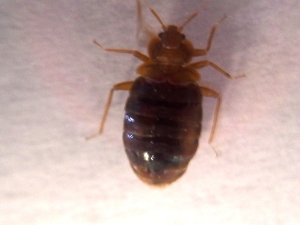The simple mention of bedbugs is enough to strike fear and anxiety into many people. There is no doubt that bedbug infestations are frustrating and time consuming. Knowing the facts and myths about bedbugs, precautions to take to prevent bringing them into your home and what to look for in the event of a possible infestation can be helpful in easing the stress that goes along with bedbug infestations. Throughout the month we will be discussing all of those topics as well as the dos and don’ts of treatment, how to research potential bedbug infested locations (hotels, motels, etc) and some of the relatives of bedbugs and a few other non-relative biting pests.
Bedbugs are primarily crack and crevice type insects. Currently there is a world wide epidemic of bedbugs as a result of increases in travel, expense of treatment and in some cases chemical resistance to pesticides. This epidemic comes after several decades in which bedbugs in the United States had been widely exterminated and were found in only small pockets of the United States. Adults are roughly the size of an apple seed or 3/8 of an inch in length and reddish brown in color. Females tend to be more round in shape whereas males more of an elongated oval. Unlike their relatives, bedbugs have adapted to living entirely with humans. This adaptation enables bedbugs to be accidentally carried from one location to another on furniture, luggage and other belongings. Locations with high rate of human turn over, such as hotels, motels and apartment complexes are highly susceptible to bedbug infestations.
Bedbugs typically feed at night, although they will feed at any time they become hungry and a host is available for a blood meal, especially if they have been deprived of a food source for a period of time. The bites are initially painless and may not immediately be felt by the host. Feeding for approximately 10 minutes or less at a time, bedbugs then return to their harborage area to digest their meal. Lines and clusters of bites are common where bedbugs congregate to feed along the edges of bedding and clothing. Reactions to bedbug bites are highly variable depending on the body of the host. Some people show little if any response and bites may appear to mosquito bite like as a small red swelling. Meanwhile, others may experience adverse reactions resulting in welt sized swellings. Reactions occur due to the body’s response to the proteins in the saliva that are injected as the bedbug feeds. While bedbugs have been extensively studied and have not been found to transmit any diseases as of this time, skin infections from scratching bites are fairly common.
Follow us in the coming weeks for additional information on precautions, infestation identification and treatment information.
